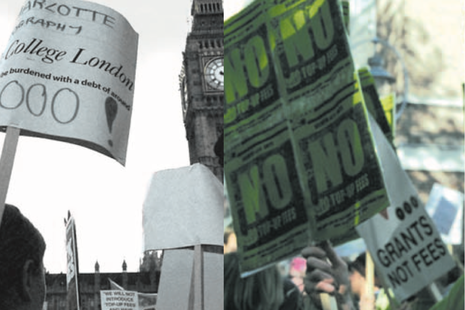Vintage Varsity: Tossling with Tuition
Resident Varsity archivist Vialli McComb reflects on past reactions to tuition fee rises and notes the same predictable arguments used by students and universities alike.

Following the recent announcement that the Government is planning to raise university tuition fees to £10,500 over the next five years, I wondered how students and the University reacted in the past to the rising cost of education and educating respectively. Whilst the arguments for and against raising fees have largely remained the same, the way in which the debate has been engaged in appear to differ.
Cambridge’s story with tuition fees (and Varsity’s journey of reporting on it) begins in 1989 when the national body of Vice-Chancellors voted to endorse plans for university students to be responsible for paying for their education. Notably, however, the Council of Senate decided to “pit Cambridge University against the nation University establishment” by declaring against the tuition fee proposals. With Varsity reporting that the Education Ministry spokesman of the time outlined the Government’s position as “a matter for the Universities to decide themselves”, it appears that the University’s extensive endowment meant the financial pressures pushing other educational institutions towards tuition fees were not felt to the same extent in Cambridge; students and Senate House found themselves on the same side.
“Some students recognised the reality of funding issues while others likened the process as commodifying education to make it seem ‘like oil’”
This contrasts deeply to the situation 24 years later in 2003 when the CUSU (the SU’s predecessor) coordinated with students across the country to take part in NUS’s march against the proposed top-up fees in Trafalgar Square. With a strong contingent of students behind him, CUSU president Ben Brinded announced plans to band with Oxford to take on the issue since “people take notice” when Oxbridge make a stand. He lobbied then Cambridge MP Anne Campbell to vote against the measures (the MP later abstained on the vote and wrote to Varsity outlining her desire to maintain realism while still exerting influence on the Bill’s contents). Senate House, meanwhile, had changed its tune and taken its place alongside other universities arguing that tuition fees and their increases were a necessary step to solve the “chronic underfunding of the university sector” as then Vice-Chancellor Alison Richards put it.
The same arguments arose in 2010 with the Browne Report that initially suggested a maximum cap of £12,000 on tuition fees. However, as might be self-evident, this figure was subsequently reduced to £9,250. Interestingly, the Browne Report envisaged universities raising their fees to reach the cap over a period of five years; reality was that most raised them to the cap as soon as possible. In the background, the same story played out in JCR’s, the CUSU, and Senate House. Although University leadership in Cambridge were in favour of the proposals, Varsity spoke to some academics who were not. One commented that the cost of higher education should not be transferred to the students from the taxpayer given the benefits provided to society by graduates and remarked that it is “surely wrong” to do so. Lines were not unified for students either; some students recognised the reality of funding issues while others likened the process as commodifying education to make it seem “like oil”.
What is most notable is the intensity of discussion surrounding tuition fees at any time. Perhaps it is too early in the discussion of the new Government’s new proposals but there is a slight feeling of apathy towards the subject; more than a decade on from the last significant changes, it feels as though students are resigned to their debt.
 Interviews / You don’t need to peak at Cambridge, says Robin Harding31 December 2025
Interviews / You don’t need to peak at Cambridge, says Robin Harding31 December 2025 News / Unions protest handling of redundancies at Epidemiology Unit30 December 2025
News / Unions protest handling of redundancies at Epidemiology Unit30 December 2025 Comment / What happened to men at Cambridge?31 December 2025
Comment / What happened to men at Cambridge?31 December 2025 Features / ‘Treated like we’re incompetent’: ents officers on college micromanagement30 December 2025
Features / ‘Treated like we’re incompetent’: ents officers on college micromanagement30 December 2025 Theatre / We should be filming ADC productions31 December 2025
Theatre / We should be filming ADC productions31 December 2025









